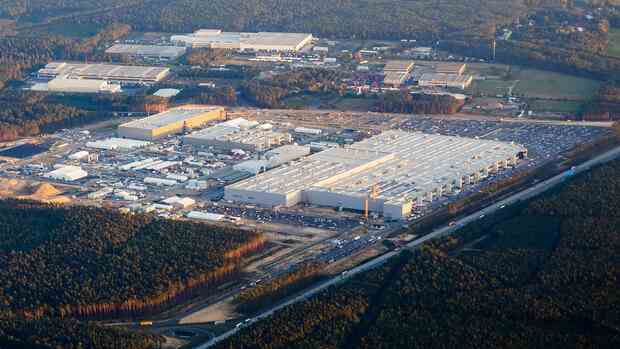Elon Musk’s flagship factory uses 3.8 million cubic meters of water a year.
(Photo: dpa)
Berlin Rising temperatures and rising costs: Germany has a water problem. In many places, the persistent heat is causing the groundwater level to drop. And the remaining water is increasingly contaminated with nitrate from agriculture. The German Institute for Economic Research (DIW) warns that both increase the costs for business and consumers in the long run. The result is increased water use conflicts between industry, households and agriculture.
In order to limit this, the authors recommend incentives to save water, especially for large industrial customers. The team around DIW economist Astrid Cullmann also has to put an end to “the preferential treatment of industry, which currently consumes large quantities at very low prices”.
The treatment costs for water increase mainly due to phosphorus and nitrate, which are flushed into the groundwater due to over-fertilization. According to estimates, an increase in the nitrate concentration by 10 milligrams per liter would lead to an increase in costs of around 110,000 euros per year for an average drinking water company with around 50,000 customers, writes the Cullmann team.
The nationwide total costs are not yet known, but they are likely to be enormous sums. Because cleaning the water is necessary in many places, numerous communities exceed the EU limit of 50 milligrams of nitrate per liter – in some cases by up to 700 percent.
Top jobs of the day
Find the best jobs now and
be notified by email.
The EU had therefore threatened Germany with fines years ago. These were recently averted by the tightening of the Fertilizer Ordinance. So far, however, there has been little improvement, as the latest nitrate report from 2021 shows.
BASF consumes as much as a small town
The DIW therefore advocates a fairer distribution of water costs and general incentives for more economical use. The institute criticizes that “we are currently observing very arbitrary pricing”. For example, three federal states did not charge any fee at all for the withdrawal of water. In the rest there are numerous exceptions, for example for mining and agriculture.
Distribution issues are generally not regulated by the price, but by order: In the event of a water shortage, for example, the administration has a volume cap for new customers or prohibits the irrigation of gardens. Large industrial consumers, on the other hand, usually receive long-term contracts at low prices, so there is little incentive to save.
Their consumption values are gigantic: The chemical company BASF in Schwarzheide, for example, removes up to 3.3 million cubic meters per year. Tesla in Grünheide has applied for around 3.8 million cubic meters per year.
The LEAG opencast lignite mine in Jänschwalde used more than 100 million cubic meters of groundwater per year, of which only 42 million cubic meters had been officially approved. For comparison: a city with 80,000 inhabitants uses about 3.6 million cubic meters of water per year.
The authors of the study criticize the lack of transparency and control over water withdrawal
In general, a lack of transparency and a lack of control over water withdrawal, as well as arbitrary prices, mean that “the needs of industry are given priority and covered at the expense of the public,” concludes the DIW authors. In addition, the prices in the federal states are extremely different: they vary in agriculture between 0.5 and 31 cents per cubic meter and in mining between 6 and 31 cents per cubic meter.
>> Also read here: Which investments in water help to combat water shortages
In addition to the introduction of market and price mechanisms, the DIW also recommends measures to reduce the pollution of river and groundwater – and thus avoid future costs. Above all, organic farming can reduce pollution.
“Empirical results have shown that if the proportion of organically farmed land increases, the nitrate concentration in the groundwater falls,” says Cullmann. The fight against over-fertilization is also a goal of the EU’s new “farm-to-fork” strategy.
>> Also read here: Fertilizer shortages, pesticide bans: Farmers and the agricultural industry fear for the harvests
A large water consumer is also the water toilet, which is common in this country. If one were to switch to dry toilets, this would on the one hand significantly reduce the consumption of fresh water and at the same time enable the production of recycled fertilizer from human excretions.
Surveys showed that the population was more open to it than expected. However, today’s laws – unlike sewage sludge, manure or biowaste – do not yet allow the use of recycled fertilizers made from human excretions that are collected separately from wastewater.
More: Greentech: Pink Elements wants to create the world’s largest platform for environmental data

